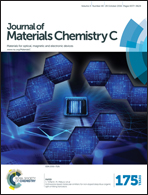Comparison study on the influence of the central metal ions in palladium(ii)- and gadolinium(iii)-porphyrins for phosphorescence-based oxygen sensing†
Abstract
The luminescence and oxygen sensing properties of a series of palladium(II)- and gadolinium(III)-porphyrins were evaluated and compared. Spectral analysis indicates that absorption and luminescence of Gd-porphyrins are red-shifted compared to those of Pd-porphyrins. This demonstrates that the energy levels of excited states in Gd-porphyrins are lower than those in the corresponding Pd-porphyrins. Phosphorescence quantum yield of Pd-hematoporphyrin monomethyl ether (HMME) was about 3-fold higher than that of Gd-HMME due to the decreased non-radiative decay rate of triplet states in Pd-HMME, which was confirmed by the longer phosphorescence lifetime of Pd-HMME. This is attributed to the higher first excited triplet state (T1) in Pd-HMME as compared to that of Gd-HMME. However, the phosphorescence intensity and lifetime responses of Gd-HMME to oxygen were larger than those of Pd-HMME. To understand this difference, oxygen quenching constants (kq) of Gd- and Pd-HMME were evaluated and were found to be 4972.9 and 26.4 s−1, respectively. The huge difference in kq between the two species is responsible for their disparate oxygen responses. We suggest that the greater kq of Gd-HMME results from the better energy matching between its T1 (12 658–14 006 cm−1) and the second excited state (13 123 cm−1) of oxygen, which was demonstrated by the higher singlet oxygen quantum yield of Gd-HMME. The same phenomena (spectral red-shifts, lower phosphorescence quantum yields, shorter lifetimes, and larger oxygen responses) were also observed upon substituting Pd(II) by Gd(III) in other porphyrins studied in this work.


 Please wait while we load your content...
Please wait while we load your content...